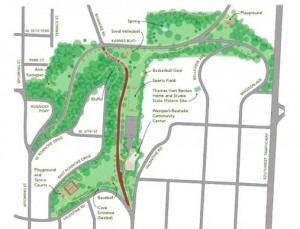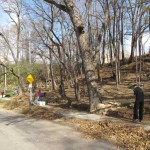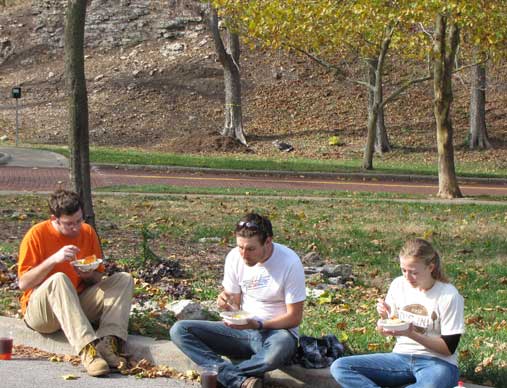
The Valentine Slope of the park, with steps leading down from Southwest Trafficway to the park, was planted with a mixture of shade-tolerant native grasses last weekend.
About four dozen volunteers from the nearby neighborhoods showed up Saturday to work on Roanoke Park as part of a long-term plan for restoration. The volunteers were able to seed and mulch two large areas of the park where invasive plants have been cleared away.
The restoration of the park is a public private partnership with the Kansas City Parks Department and the neighborhoods that directly surround the park: Volker, Valentine, Roanoke and Coleman Highlands. The efforts began in 2012.

Roanoke Park is located north of 39th Street and west of Southwest Trafficway. It’s borders are shared by the Coleman Highlands, Valentine, Volker and Roanoke neighborhoods.
Roanoke Park was designed by George Kessler and developed between 1906 and 1909. It lies in a wooded ravine surrounded by rocky bluffs, and the park in its early days encouraged the development of fine homes on its top rim.
The park is the home to Westport Community Center, a soccer field, small basketball goal, a popular sand volleyball court, a ball diamond, and three playgrounds. A group of bicyclists called Earth Trail Riders is creating trails in the park for biking and hiking.
From the earliest days, the Roanoke Parks and the Parks and Boulevard system as a whole was intended to serve residents and encourage development. But in 2010, residents of the neighborhoods around the park came together to try to turn around years of neglect.
Even when Kansas City was not in such dire financial straights, city resources for the parks have been sparse. Many neighborhood parks are being recognized for their value as neighborhood assets and sanctuaries of peacefulness in urban areas. This trend is sweeping the nation and the globe as neighborhood groups join together to support local parks that have suffered from urban decay and government neglect.
From the Roanoke Park master plan

Volunteers working on the park planted the areas once covered with invasive, non-native plants with native ones. The park’s master plan called for native plants because they are preferred for their “variety, drought tolerance, and ability to sustain local birds, insects and animals.”
When work began, according to the master plan, the park was overgrown with “the non-native invasive shrub honeysuckle, spreading wintercreeper and Ailanthus trees. These plants combined to crowd out native ground covers, impairing the health of the park’s existing trees and reducing seeding establishment. Other non-native invasive species included garlic mustard, multiflora rose, and the usual array of turf-grass weeds,” according to the master plan.
So volunteers began tearing out the non-native plants two years ago and the park’s natural features were once again visible. That’s lead to last week’s planting of native plants on the hillsides and bluffs around the park.




Who’s talking